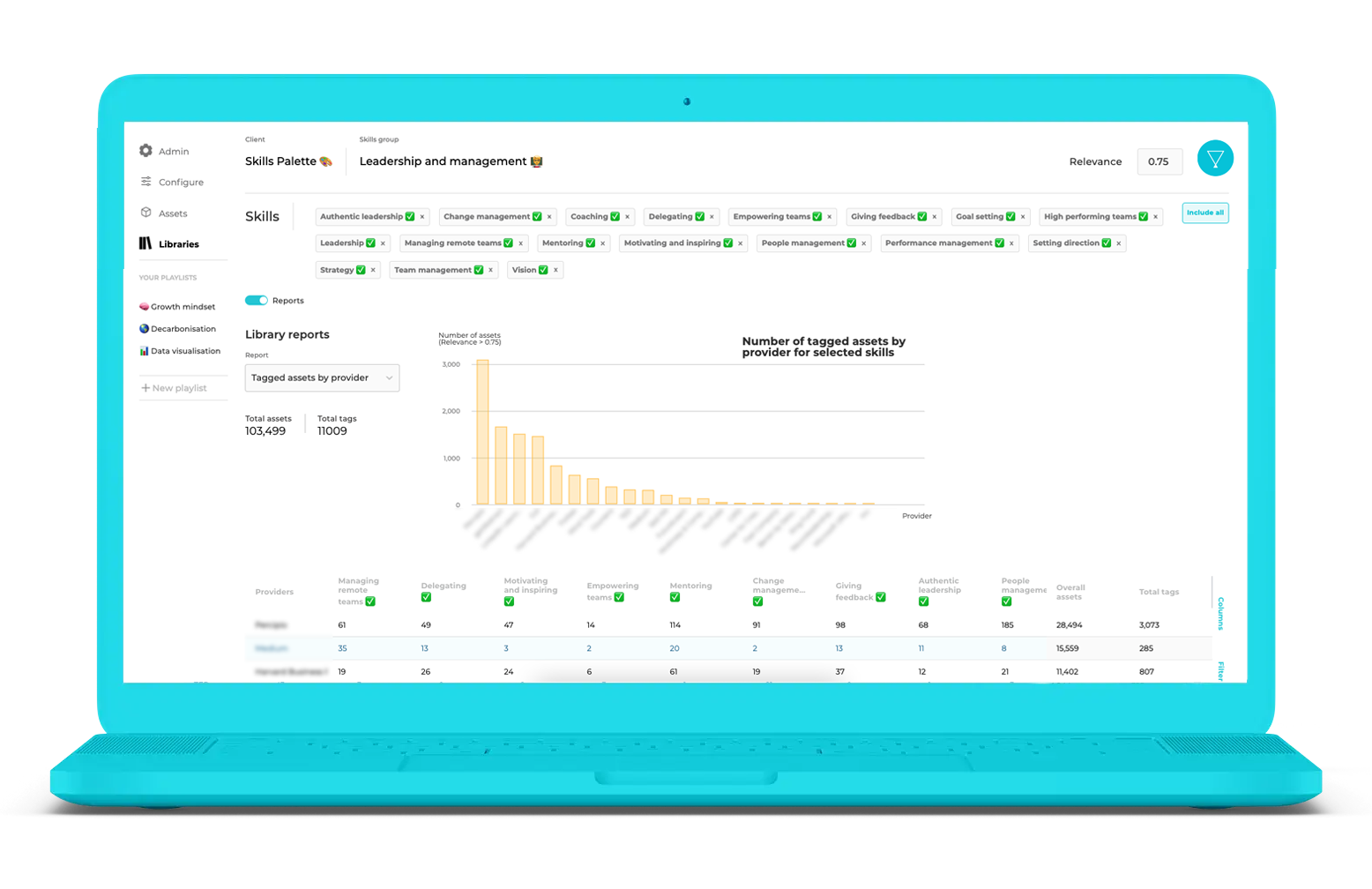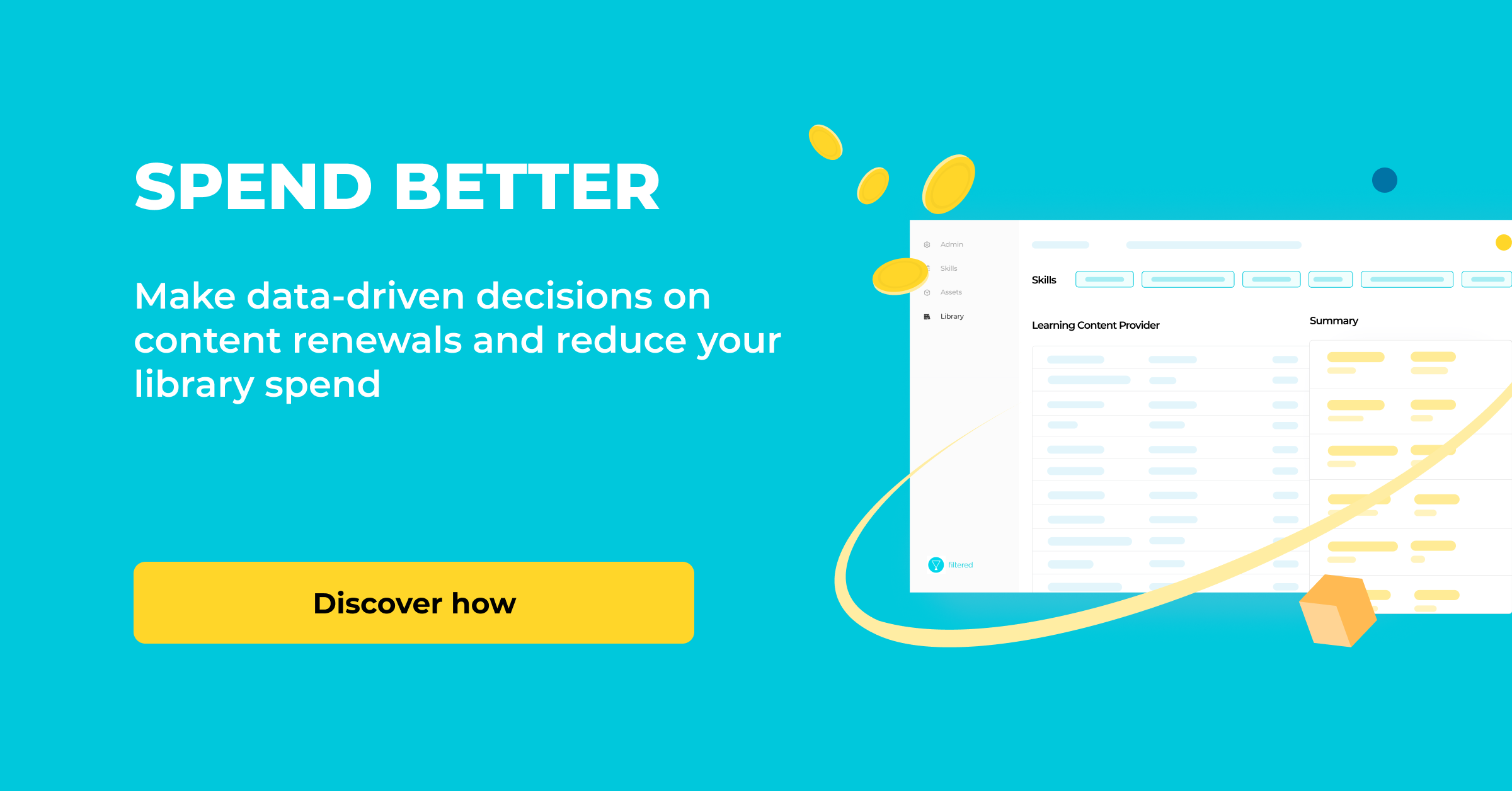Content itself is just data.
That’s what Filtered CEO Marc Zao-Sanders, recently said.
He continued with a message of hope:
There are trillions of data points in learning content itself. Each word, each sentence, each juxtaposition of a paragraph is data that algorithms can make sense of ... if we know how to configure them, apply them, and interpret their results.
Marc’s thoughts on data and content eventually led to our Content Intelligence solution — a platform that helps organisations make data-driven learning content procurement and curation decisions.
And content — specifically content libraries — are a multi-billion dollar industry. In fact, the average annual cost of content libraries for large organisations is £200,000. That number is 5x (£1m+ per year) for global enterprises.
Yet, thanks in part to an overabundance of content (aka “content overload”), many organisations are not clear on which content actually builds the skills necessary to help their employees (and thus the company) grow.
Fact: At Filtered, we have worked with clients where we’ve identified close to 30% of their content as redundant thanks to irrelevance or overlap.
All of the above is negatively impacting L&D when it comes to procurement. In this article, we’ll share how L&D is doing procurement wrong and what needs to change as we move through 2022 and beyond.
Issue #1: Lack of data (and metadata)
When buying learning resources, learning and development teams often run into some problems with ... data. And metadata.
Unlike data-rich companies (think: YouTube, Facebook, Spotify, etc.), content data in the L&D space is a bit more challenging to find. The usage on those platforms is nearly constant, hence lots of data to cull through and analyse.
In L&D (Learning & Development), we look to DPLA or Data Per Learning Asset. And, not surprisingly, most assets in most companies are never even glanced at, let alone read and absorbed. Yet, without that content data, it’s nearly impossible to make the “stay or go” decision — not to mention challenging to make it data-driven.
Instead, often, the response is, “Well, nobody is consuming that content, so maybe it’s time to get rid of it ... or add more.” << often the poor choice.
Filtered helps its clients look at 5 vital data-driven metrics as a starting point:
- Opens
- Completes
- Relevance
- Usefulness
- Search
These metrics help uncover the good (performing well) and the not-so-good (gaps) in learning content.
From there, we can start to look at the bigger picture and use Content Intelligence to analyse content and libraries by skill coverage – more on that later on!
From there, we can start to look at the bigger picture and use Content Intelligence to analyse content and libraries by skill coverage – more on that later on!
But data is just one issue.
Issue #2: Too much focus on big brand libraries
11.3%. That’s the projected compound annual growth rate of the corporate eLearning market by 2025 ... and that’s a global market valued at over $100 billion in 2019.
It goes without saying, this market growth equates to more (and more) learning content. These libraries are already enormous: Skillsoft has 40,000 assets while LinkedIn Learning has about 20,000. GetAbstract clocks in at 8,000 while MindTools boasts 3,000.
That’s a lot of content. And not nearly enough time, especially when you consider the average employee only has 24 minutes/week to learn.
Until recently, much of the focus on eLearning has been concentrated in the “big brand” arena — Skillsoft, LinkedIn Learning, and others mentioned above.
Brian Murphy, Global Head of Learning & Future Skills at AstraZeneca, agrees:
“The learning content library market is a fast-growing space with a lot of players, and I think a lot of companies are swayed by big brands and impressive course titles.”
Mr. Murphy continued, “But we weren’t happy with this. We saw the opportunity to invent a whole new way of evaluating and managing this area of the learning marketplace. We had to professionalise this area and take the initiative.”
Which is exactly what they did (leading to a Learning Award nomination)!
Dedicating too much time (and money and resources) to the big brand content means organisations are missing out on the free — and often very, very good — content that lives on the Internet.
Wait. Did someone say FREE CONTENT?
Issue #3: Failure to take advantage of the best FREE content
While it’s not a simple task to estimate the total number of websites currently on the Internet, suffice to say there is a lot of content on the web, most of it free.
Yes. FREE (all caps intentional).
Note: Some estimates place this number somewhere around 1.2 billion ... and growing by the second, but that obviously depends on when you are reading this article. And Google stopped counting after 130 trillion pages.
As we’ve said before, when it comes to quantity and quality, the best of the web is better than any content library. The keyword? Quality (and consistency and cohesiveness). On the flip side — and equally important — the worst of the web is worse than any library too!
Part of the reason organisations hire a company like Filtered is because it can be overwhelming to find the “best of the best” (free) content online. Culling through troves of articles to uncover takes time (human capital) and resources (often financial). And that still does not guarantee ideal results.
Companies like Filtered will curate (Filter!) that content and match it with the skills your company has identified necessary and essential for upskilling.
This free online content “fills the gaps” (yes, there are always gaps!) with videos, blog posts, articles, community-driven content, and more. The result? Learning optimisation.
Speaking of skills ...
Issue #4: Not linking content buying to skills
Skills.
Upskilling.
Reskilling.
Skills are the new currency of work — yet that currency is imperfect and wholly inconsistent.
Since March of 2020, skills have become even more critical. As the world seemingly changed overnight for entire industries and the organisations and employees that run them, there was an immediate shift — new priorities, different job roles, and a (significantly) more remote workforce.
The data support that proclamation: According to the 2021 L&D Global Sentiment Survey, over 3,000 practitioners globally thought reskilling and upskilling were the most important activities for L&D.
But too many L&D departments are not linking content buying to skills. Eeks.
One reason may be due to the fact that designing a skills framework can be tricky. Organisations often fail not only to understand but also to agree on the necessary skills for their employees.
Here at Filtered, we like to think of the process as simple, straightforward, and relatively quick. Filtered can produce a list of between 10 and 50 skills that apply to everyone in your organisation AND address needs immediately in just three weeks.
Here is what it looks like in the Filtered platform:

We accomplish this by using multiple data sets to map your organisation’s skill areas to your roles. We also analyse your company data and draw out the most pertinent skills to provide a data-driven, prioritised skills framework.
Skills = Content. Everyone is happy.
Issue #5: Missing the boat on RFPs
A “Request for Proposal,” or RFP, is a formal announcement posted by an organisation where vendors can “bid” on the project, and the posting company can choose which one best suits the project needs and budget.
When it comes to procuring learning content, many companies are either over-complicating or not adding enough rigor to the process — both extremes lead to less-than-ideal proposals, frustration, and wasted time.
We propose a 7-step RFP process:
- Problem statement: Clearly state the problem(s) the content you intend to purchase is should solve.
- Internal team: Don’t go at it alone! Build a cross-functional team representing many perspectives from several key teams — ideally ones that will use the learning content!
- Learning content RFP scorecard criteria: Create a sound, clear, easy-to-understand decision-making rubric. This will help evaluate each vendor, taking your initial list down to a shortlist, and ultimately make the decision of which vendor you choose to partner with an easy one. Be sure to map the vendors to the skills your organisation requires.
Note: This process, when done manually, can be tricky. At Filtered, we lean on Content Intelligence to automate (and produce more accurate results).
- Learning content RFP document: Build out that RFP — one you and your company are proud of (it will be externally facing) and, of course, one that is effective.
- Content library longlist: This can be done by creating several categories. We recommend segmenting your list of learning content providers into the “types” they represent — general-purpose, format-focused, marketplaces, aggregators, MOOCs, subject specialists, web crawlers, and the web itself.
- Content library shortlist: Next, combine #3 (scorecard) with #5 (longlist) to create ... a shortlist. Vioila!
- Final evaluation and decision(s): It’s content provider interview time! We recommend at least 90-minutes per shortlisted vendor. Be sure the final decision is a collective, collaborative one.
For a deeper dive on this topic, check out How to run a learning content RFP.
The time is NOW to get L&D procurement right.
If you are in the market for an L&D purchase, the time is ripe to get the solution that fits your needs (and budget).
There is so much good, often free, content that just needs to be aligned with skills, culled and curated, and tagged appropriately.
Filtered is here to help.
Learn more about our Content Intelligence solution and get your L&D procurement process kicked off the right way!


